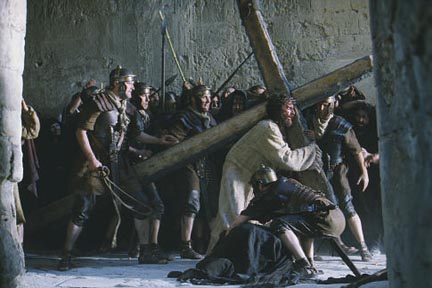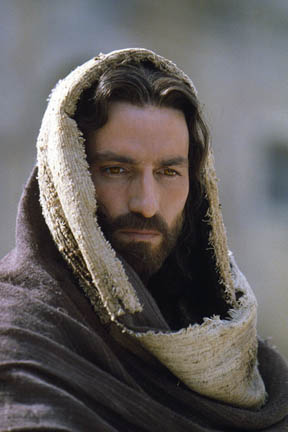
ICON DISTRIBUTION
"The scenes had to be like an old Renaissance painting, so we lit many scenes with a golden sheen," cinematographer Caleb Deschanel said.
A moving Caravaggio
Embodying Christ in 'The Passion of the Christ'
Ancient language transcends all current cultures
Screenplay blends epic qualities and intimacy
BEVERLY HILLS, Calif. >> Caleb Deschanel sits with amusement at the Four Seasons Hotel in Beverly Hills where swarms of people outside are waiting for a Hollywood encounter.
"I don't think it's me everybody is waiting to see," says the cinematographer. "It's probably that Mel Gibson fellow who for months put me through such an ordeal."
He laughs before recalling what it was like to work on Gibson's controversial "The Passion of the Christ," which opens Wednesday, with Jim Caviezel playing Jesus.
Gibson warned Deschanel, 59, cinematographer on "The Natural," "The Right Stuff" and "The Patriot," that "Passion" would not be "ordinary."
"He said that aside from difficult conditions and locations, there might also be emotional and spiritual issues to deal with," Deschanel said. "He was right. Everyone who worked on this film came away a changed person."
"The Passion of the Christ" tells the story Jesus' final 12 hours, culminating with his flagellation, crucifixion and resurrection. The two-hour film is spoken entirely in Aramaic and Latin, the languages spoken in Jerusalem in Jesus' time. (Subtitles are provided.)
Deschanel, a Quaker, saw "Passion" as a political drama as well as a religious tale.
"In its simplest form, 'Passion' is about a bunch of powerful guys, the Pharisees, afraid that this new guy in town who's attracting a lot of attention from the townsfolk by calling himself the Messiah was threatening their control, so they wanted him gone, done away with."
Deschanel's aim was to ensure that the photography told everyone's story while following Gibson's orders to avoid having it come off as "some cheesy Hollywood epic."
Gibson said, "I told Caleb that I wanted a look matching the dramatically lit works of the Italian Baroque painter Caravaggio."
For weeks the two thumbed through books of Caravaggio's works.
"It's probably the most research I've ever done before a film," Deschanel said. "I would come back with stacks of examples, and Mel would look at each one almost yelling, 'Yes, yes, yes.'"
Gibson said what is known about Caravaggio comes from prison records.
"He was a wild man, a rabble-rouser," Gibson said, "but his work is beautiful, violent, dark, spiritual with an odd whimsy to it."
"The scenes had to be like an old Renaissance painting, so we lit many scenes with a golden sheen to make them compelling," Deschanel said.
To achieve the effects, 40 percent of the film was shot at night or indoors in low light.
"It's odd, but low-lit scenes usually take a lot more lighting than brightly lit scenes," Deschanel said. "You have to bend light, subdue it, yet still be able to light an area to be filmed."
Gibson was awed by early results.
"I remember telling Caleb, 'Oh my God, it's a moving Caravaggio!'" Gibson said.
Originally, there was no plan to use subtitles.
"(Mel) believed words running along the bottom of the screen would somehow spoil the effect he wanted to achieve," Deschanel said. "He hoped to be able to transcend the language barriers with his visual storytelling. I wasn't sure if I was good enough."
ICON DISTRIBUTION
James Caviezel's makeup sessions often lasted seven hours to transform his body into "an oozing mass of wounds."
THE CRUCIFIXION SCENES were filmed in Matera, Italy, where Pier Paolo Pasolini shot the 1964 movie "The Gospel According to St. Matthew."
"Certain sections of the city are 2,000 years old," Deschanel says, "and the architecture, the blocks of stone and the surrounding areas and rocky terrain added a vista and backdrop that we used to create the backdrops for our lavish sets of Jerusalem," built on 2 1/2 acres.
"We relied heavily on the look that was there. We all thought it was perfect."
The film's opening scene sets the tone for the film, with Jesus praying at night in the Garden of Gethsemane, a muted shaft of light tinted by a blue gel illuminating his face to create a feeling of isolation, mystery, danger and predestination, Deschanel said.
The early scenes are not the film's only allusions to classical art.
"Maybe the most compelling is at the foot of the cross when the body of Jesus is being removed for burial," he says. "Mary (Maia Morgenstern) cradles the lifeless body of her son in exactly the same pose used by Michelangelo in his famous Pieta, one hand cradling his body and the other open toward the viewer."
This depiction is slightly altered in the film.
"Michelangelo's Mary gazes solemnly down at her Son, but Mel's Mary looks straight out at us," Deschanel says. "The movie ends, provoking a full and conscious acknowledgment of whom this suffering has been for."
DESCHANEL learned his craft at the American Film Institute, launching his career as assistant to photographer Gordon Willis before handling second-unit photography for Francis Ford Coppola's "Apocalypse Now" (1978). One of Deschanel's first major credits was for Coppola's "The Black Stallion" (1979). He also filmed 1999's "Anna and the King."
Oscar nominations followed for his work on "The Right Stuff" (1983) and "The Natural" (1984). He also was instrumental in developing the Steadicam system, which assures steady camera movement under any circumstances and which he would later refine into a "skycam" system for aerial photography.
If his last name sounds familiar, it's because while he remains in the background to audiences, his daughters Zooey and Emily, and his wife Mary Jo, are actresses.
While Deschanel once believed a director of photography's work should be unobtrusive, he now believes his is a collaborative art, with room for artifice.
"I really believed that the DP's job was to create this perfect reproduction of reality -- totally naturalistic," he said. "But I've evolved through the years to understand that you have to take big chances in your work, as long as those risks are in sync with the drama you're telling.
"If you're really in tune with your story, you can get away with some incredibly exaggerated visuals which actually help to push the momentum of the story forward."
IF A CINEMATOGRAPHER needs to earn an actor's trust to capture intimacy, then Deschanel and Caviezel are stage blood brothers.
"Jim went through a real ordeal," Deschanel says. "He knew what we wanted, what we needed, and did it. He took suggestions very well. But sometimes the weather would cause lighting problems and we'd have to wait, and he'd be in that loincloth and the temperature was 40 degrees.
"It was imperative to get the shots right with the fewest takes possible."
Caviezel's makeup sessions often lasted seven hours, transforming his body into an oozing mass of wounds. The crucifixion scenes took 15 days and the flagellation six days to film, largely because of Gibson's attention to details.
Twice during the scourging scenes, a whip end lashed Caviezel rather than the protective covering made up to look like skin. Deschanel captured the actor's agony and says for the most part, he was so focused on filming that he was not affected by the film's violence.
"The camera was like a shield for me," he said.
Despite Deschanel's cool demeanor, he did feel pressure filming what many consider to be the greatest story ever told.
"There was a sense of tremendous responsibility," he said. "A few times when we had thunder or lighting, I would look into the sky and think, 'Guess you didn't like that take, huh?'"
Click for online
calendars and events.


